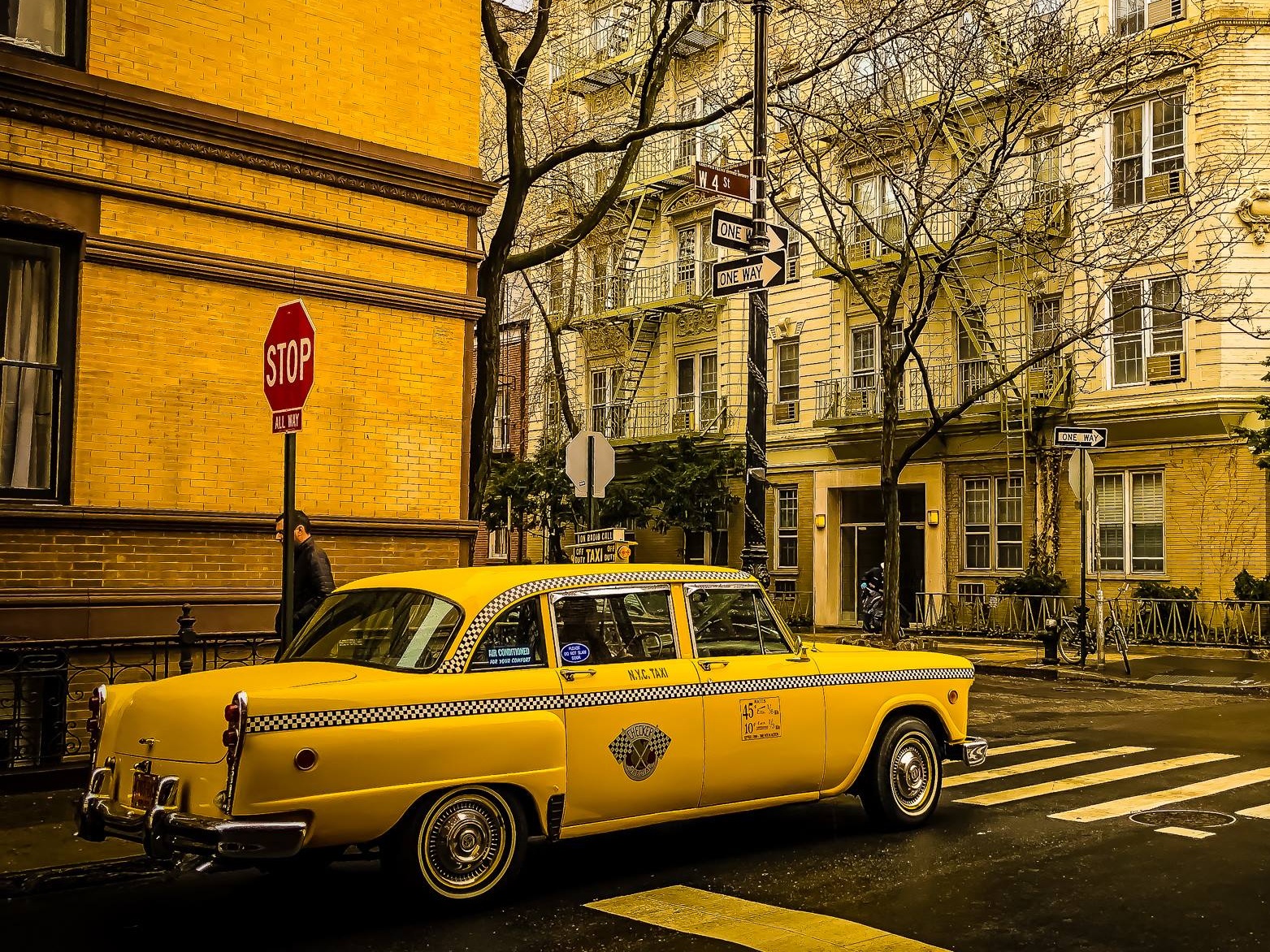NYC's Iconic Yellow Cabs: Taxi Memories
By Lucas Compan
The New York City cab is more than just a car that happens to be painted yellow. It’s part of the city’s urban scene and history. It’s a legend. As New York City has started implementing the taxicab of the future, let's take a look at the history of the city's iconic yellow cab.
the yellow cabs in the 1970s. image: NYPL
1900s
The first taxicabs to ply the streets of New York City were horse-drawn carriages, like this hansom cab that became widely used in the early 19th century. Licensed by the city, many of the early taxi drivers were African Americans or Irish immigrants, eking out a living as small entrepreneurs.
An early electric hansom taxicab on a New York City street, circa 1900. The Electric Carriage and Wagon Company, the first taxicab company in New York City, began operating 12 electric hansom cabs in July 1897—a time when city traffic was overwhelmingly of the horse-drawn variety.
(Image credit: Nathan Lazarnick—George Eastman House)
1920s
By the 1920s, as demand for autos boomed, industrialists had recognized the potential of the taxi market. Automobile manufacturers like General Motors and the Ford Motor Company began operating fleets of cabs. Here, a New York City yellow cab in 1929.
(Image: courtesy Museum of Modern Art)
(Credit: New York State Museum)
Hop on and let’s take a taxi ride in NYC in the 1920s
1930s
Nicknamed the "Sunshine" cab, taxis with a European-style sun roof were put into service in New York, June 19, 1936. The new fleet was the largest single order for new taxicabs in history.
J. Stirling Getchell—AP
How did New York City look like in the 1930s?
1950s
The new model taxicab from Chevrolet is shown in New York City, May 17, 1950.
Carl Nesensohn—AP
1970s
Taxicabs drive through the streets of Manhattan near 5th Avenue in New York City in the 1970s. This picture is from 1972. The vehicles' signature yellow livery didn't become law until 1967, when the city ordered that all licensed "medallion taxis" be painted the same color, in order to cut down on unofficial drivers and make the cabs more recognizable.
Taxi driver, psychologist, and photographer
( WATCH ) See old New York through Joseph Rodriguez’s lens. He drove a cab from 1977 to 1985, and in the last two of those years, he was studying to be a photographer. He lost his first set of gear in a classic '70s New York stabbing and mugging, but with a new camera, he documented what he saw on the job.
In 1974, Time magazine described the city's cabs as "among the world's sleaziest: cigarette butts and paper coffee cups on the floor, dirty windows, leprous upholstery, chewed gum and sticky candy wrappers on ripped seats."
Another article that appeared in Time a couple years later was no less charitable, arguing that"In New York City, nothing is more onerous than debt and taxis." The writer complained of a "claustrophobic bulletproof shield between driver and passenger" and said the entire design of the cab was aimed at forcing the customer into "a paralytic yoga position: fists clenched into the white-knuckles mode, knees to the chin."
Though Checkers were still widely available, there was a new dominant vehicle: that old workhorse, the Dodge, as seen in the 1970s Jack Nicholson film "The Last Detail."
In 1970, the city also passed a law making yellow the official color for all medallion taxis.
( WATCH ) New York City back in the 1970s
1980s
The Checker Cab, used between 1956 and 1982, became one of the most recognizable symbols of mid-20th century of New York City's urban life. Manufactured by the Checkered Cab Company, the iconic black-and-yellow taxi was advertised as a roomy and rugged alternative to the standard American passenger sedan.
an original checker cab in the west village in 2019. photo: @lucascompan
an original checker cab in the west village in 2019. photo: @lucascompan
( WATCH ) A real former checker-cab from 1980s in 2011
( VISUAL STORY ) Now take a fantastic visual tour of NYC back in the 1980s
The last original Checker Taxicab
( WATCH ) Meet the lone remaining New York City Checker taxi driver Johann Struna. The beloved iconic Checker cab drew astounding passersby approval all over town.
1990s
By the 1990s, the battle to dominate the taxi cab industry came down to two dull but pragmatic vehicles: the Chevrolet Caprice and the Ford Crown Victoria.
an old crown vic in 2012. photo @lucascompan
the Ford Crown Victoria. Photo: google
While these cars didn't have the flair of cabs of earlier decades, they tended to endure the heavy use of cab drivers. Police also used Crown Victorias, and once those were retired they could be recycled as cabs.
1991 Chevrolet Caprice. Image: Daniel Strohl
But some people criticized the four-door sedans known as "Crown Vics" for their soft suspensions and awkward back seating. The Caprice was retired from production in 1996, leaving the Crown Vic the cab of choice for much of the rest of the 1990s and into the 2000s.
( VISUAL STORY ) Now take a fantastic visual tour of NYC back in the 1990s
( VISUAL STORY )fantastic visual tour of NYC back in the 1990s
2000s
AM New York reports: In the 2000s, the face of the city's cab fleet diversified significantly, with hybrids, minivans and SUVs being introduced. Toyota, Honda and Isuzu vehicles could be seen roaming for passengers.
Still, the Crown Vic remained the old standby even as plans were being made to replace the entire fleet with all-hybrid vehicles or a so-called "Taxi of Tomorrow" promoted by City Hall. But court battles and politics delayed progress toward either.
Nevertheless, the Crown Vic was finally put out of production in 2011, forcing cabbies to select alternatives. The Taxi and Limousine Commission has approved dozens of vehicles for use, from the Toyota Prius to the Dodge Caravan.
the hibrid taxkcab
2010s
In 2011, Uber announced it was launching its ride sharing service in New York City, ushering in a new era of disruption in the taxi service industry.
image:courtesy of waave
By allowing anyone to basically be a taxi driver with their own private vehicle and making it easy to click for a ride using a mobile phone app, Uber began establishing a new network of cabs outside the medallion system. Drivers were plucked from the existing livery cab business, and vehicles didn't have to be of any particular color. Now Uber got company: Lift, Via, Waave – and others.
Green in 2013
After decades when medallion taxis were painted yellow, a new color was introduced to the palette of cab driving in 2013: green.
The city had created a new class of medallion taxis to serve the outer-boroughs, and made the decision to go with a color that would make sure anyone trying to hail one would know the difference.
The decision to introduce the green taxis meant greater service in the outer-boroughs, where taxis had been limited and black livery cabs had long been dominant. The black cars could only be hailed by phone call; the green cabs could be hailed on the street like a yellow cab.
image: courtesy TLC
The Taxi of Tomorrow
The city's fleet of 13,587 yellow medallion cabs (2015) will likely look a lot more uniform in the years ahead. That's because policy makers have been pushing to require operators replace retiring cabs with the so-called Taxi of Tomorrow, a Nissan NV200. Taxi operators who choose not to buy hybrids must choose the NV200.
The boxy minivan-like vehicle was chosen after an international competition back in the Bloomberg years, but its rollout was held up by litigation until December 2014. The Nissan NV200 packs a formidable set of features: cargo room for luggage, USB charging ports, sliding doors, lights that alert other drivers that doors are opening and even a transparent roof that "gives riders stunning views of city sights and skyscrapers," the company crowed.
In January 2016, the fleet was required to begin migrating to wheelchair accessible cabs with a goal of making 50% or more accessible by 2020.
the nv200 in chelsea, manhattan, new york city – pictured here from the high line by @lucascompan
New York City taxicabs colors explained
(WATCH) Why does New York City has yellow, green and black taxis? The answer is a mix of history, politics and economics.
Related stories
More stories of New York City
- art 41
- bars 7
- bronx 1
- brooklyn 34
- carousel 3
- cars 2
- culture 45
- filmmaking 76
- food 29
- history 72
- holidays 14
- italy 19
- kids 46
- kids1 45
- landmarks 73
- lists 90
- manhattan 80
- music 1
- new york 145
- parks 9
- personal stories 29
- photography 79
- queens 29
- sculpture 3
- staten island 9
- summer 5
- the bronx 4
- things to do 111
- top secrets 81
- tours 110
- train 2
- waterfront 2






